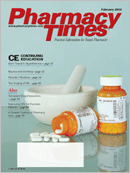The Graying of HIV
The 1981 headlines screamed: "Rare Cancers Found in Homosexual Men"(sidebar1-5). By year's end, the Centers for Disease Control and Prevention (CDC) reported 159 cases of infrequently encountered cancers.1 Eventually identifying the commonality?human immunodeficiency virus (HIV)?provided little comfort. Prognosis was poor: no single medication helped, and interventions for opportunistic conditions were limited. Beginning with 682 deaths reported in 1982, mortality rates escalated exponentially.
The situation looks considerably different today: multiple agents exist, and HIV is no longer perceived as a shortterm fatal condition. It is not unusual for practitioners to treat aging patients who were infected more than 20 years ago.
Unintended Consequences
Today, 85% of HIV-infected patients live longer than the 10 years that the earliest victims could expect to live, and mortality continues to decrease from the 1995-1996 peak.6 One quarter of HIV-infected patients die from causes other than immune failure.2 Success, however, has not been without unforeseen consequences from long-term pharmacotherapy or from HIV itself. Common complications include the following:
- Dyslipidemia (high total cholesterol, low high-density lipoprotein [HDL] cholesterol, high triglycerides)
- Metabolic syndrome and insulin resistance with hyperglycemia
- Lipodystrophy (fat accumulation)
- Lipoatrophy (subcutaneous fat loss)
- Osteoporosis and osteopenia
- Increased coronary disease risk
- Micronutrient deficiencies7,8
Additionally, elevated serum lactate, avascular necrosis of the hip, hypogonadism, and hypertension are common.7
Although many of these effects have been attributed to highly active antiretroviral therapy (HAART), including protease inhibitors (PIs),7 HIV itself decreases HDL and low-density lipoprotein (LDL) substantially.9
Cardiovascular Risk
HAART increases cardiovascular risk. Following 2 to 4 years of HAART, myocardial infarction (MI) risk increases by 26%, probably due to dyslipidemia.9 In a phase 2 study of the PI ritonavir, for example, total cholesterol increased by 200% to 300%.10 Metabolic syndrome also increases coronary risk, and treatment with PIs increases metabolic syndrome and future coronary disease.9 Both lopinavir/ritonavir and stavudine have been associated with metabolic syndrome.9
According to the Infectious Disease Society of America and the Adult AIDS Clinical Trials Group, all HAART recipients should have their lipid levels tested before beginning therapy, then every 3 to 6 months. Clinicians can compute a patient's 10-year risk from cardiac death or MI using the Framingham risk calculation method (available at: www.nhlbi.nih.gov/guide lines/cholesterol/index.htm).6 The LDL target level is determined by the number of presenting risk factors. When triglycerides exceed 500 mg/dL, the primary goal is triglyceride reduction to reduce pancreatitis risk.
Treatment of HAART-associated dyslipidemia involves lifestyle changes, lipid-lowering agents, and possibly switching PI agents. Patients with HIV should exercise a minimum of 30 minutes daily 5 days a week and should eat a healthy diet.6,11 Lipid-lowering agents, although useful, have not always achieved target levels in HIV patients. Simvastatin and lovastatin should be avoided in patients taking PIs. Atorvastatin and pravastatin with fenofibrate can be used with caution. Many PIs interact with the cytochrome P-450 system, creating potential problems.6
Some PIs appear to carry a higher risk of dyslipidemia than others, and prescribers should consider switching to another PI (eg, atazanavir has less risk) and/or to a non-PI combination regimen.9 In any case, maintaining low viral loads is essential.6
Insulin Resistance
Up to 63% of patients taking PIs develop poor insulin sensitivity,10,12 so glucose-regulating therapy should augment diet and exercise. Data on the long-term use of glucose-sensitizing agents in HIV patients on HAART are lacking.12 Metformin, however, improved glucose tolerance and reduced waist circumference by 13% in HIV patients treated for insulin resistance.12
Body Composition and Fat Distribution
Lipodystrophy and lipoatrophy, which may occur simultaneously, might be caused by mitochondrial activity. Up to 49% of patients have one or more signs of fat redistribution, and treatment duration and drug regimen are major risk factors, as is starting therapy with high viral loads.12 Interventions are limited and do not fully reverse and/or prevent lipodystrophy and lipoatrophy. Switching from PIs to other classes may help.7 Although PIs are associated most strongly with fat changes, nevirapine, efavirenz, and stavudine also are implicated.10
Recombinant human growth hormone (HGH) has been shown to reduce visceral body fat by 50%, but improvements disappeared after treatment cessation.12 Its risks and costs preclude its long-term use. Clinical trials of an HGH analogue that stimulates the body's own HGH production are under way.
Cosmetic surgery including liposuction and facial implants (the FDA approved Sculptra in 2004 for HIV lipoatrophy) improve appearance. Liposuction outcomes tend to be temporary, and fat accumulation often returns within a few years. HIVassociated adiposity tends to be unusually fibrous, and some surgeons have difficulty with the suction cannula13; patients should seek experienced surgeons.
Finally, exercise training, particularly aerobic activity, helps to reduce total body and visceral fat and to normalize lipid profiles. Exercise does not seem to affect CD4 counts or circulating viral RNA.14
Micronutrients
Deficiencies of vitamins A, B6, B12, C, and E and carotenoids, selenium, and zinc have been observed in HIV patients. Multiple factors contribute to these deficiencies and affect immune functioning. Deficiencies often accompany CD4+ cell declines and rapid disease progression.8 Although supplements may seem appropriate, optimal levels for immunocompromised patients have not been established, and excess levels may be harmful. Zinc is essential for immune functioning, but increasing zinc levels may accelerate viral replication.8 Nevertheless, many practitioners often collaborate with nutritionists to guide supplementation.
Closing Note
Practitioners agree on one principle: the benefits of maintaining low viral loads outweigh the increased risk for metabolic disorders. Many patients find lipodystrophy and lipoatrophy disfigurement stressful and become nonadherent, presenting both counseling and treatment challenges. When managing graying HIV patients, practitioners are in uncharted territory.
Dr. Zanni is a psychologist and health-systems consultant based in Alexandria,Va. Ms. Wick is senior clinical research pharmacist at the National Cancer Institute, National Institutes of Health, Bethesda, Md. Views expressed in this article are those of the authors and not those of any government agency.
For a list of references, send a stamped, self-addressed envelope to: References Department, Attn. A. Stahl, Pharmacy Times, 241 Forsgate Drive, Jamesburg, NJ 08831; or send an e-mail request to: astahl@ascendmedia.com.

